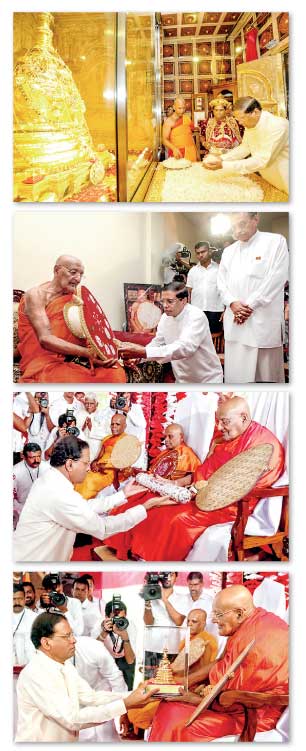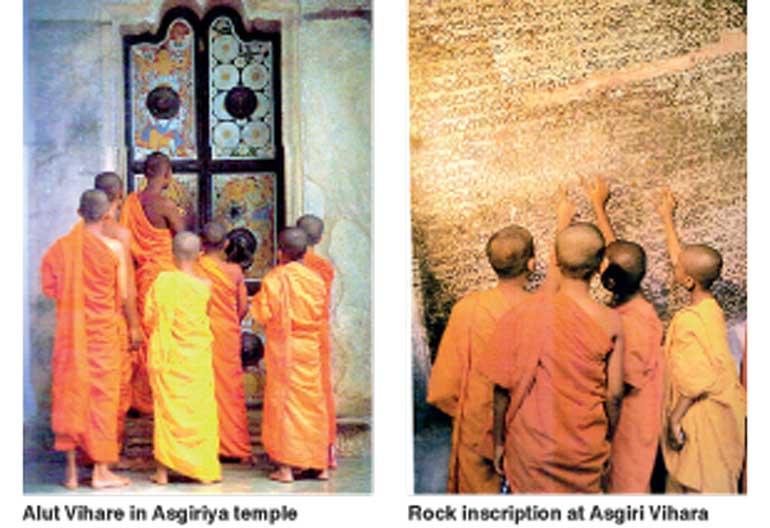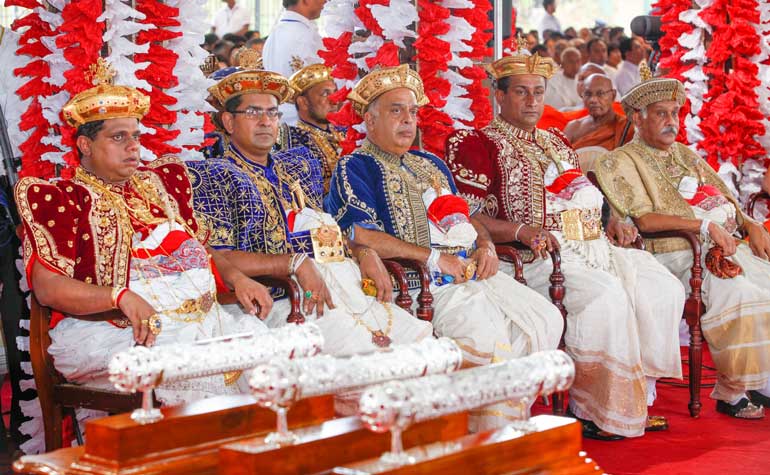Thursday Feb 13, 2025
Thursday Feb 13, 2025
Saturday, 11 July 2015 00:00 - - {{hitsCtrl.values.hits}}

 By D.C. Ranatunga
By D.C. Ranatunga
Early this week Kandy witnessed a unique, solemn and dignified ceremony dating back to the days of the Kandyan kings. The newly-elected Chief Prelate of the Asgiriya Chapter of the Shyamopali Maha Nikaya, Most Ven. Galagama Dhammasiddi Sri Dhammananda Aththadassi Mahanayaka Thera received the Act of Appointment from the Head of State, President Maithripala Sirisena. Just as much as the ceremony followed the age-old traditions, it was held at the Magul Maduwa, the Audience Hall used by the kings.
Going down on his knees, President Sirisena handed over the ‘akta patra’ – the document conveying the unanimous decision of the Karaka Sangha Sabha, the Executive Council of the Chapter – to appoint the Nayaka Thera to the prestigious position as head of the Asgiriya Chapter. He also handed over a gold relic casket to signify the momentous occasion. He was followed by the Prime Minister who presented the Mahanayaka Thera with a silver casket.
The occasion was unique because two Anunayaka Theras of the Chapter also received their Acts of Appointment at the same ceremony. This is the first time that after the Kandyan kingdom was taken over by the British 200 years ago that a Chief Prelate and the two Deputies received acts of appointment on the same day at a single ceremony.
Prior to the ceremony at the Magul Maduwa, the President met the prelates at the Asgiriya Maha Vihara and handed over the ‘vijini pat’ – fans which symbolise the prestigious appointments – to the three Nayaka Theras. While it is customary for monks to carry fans with them when they deliver sermons or attend any function, those of the titular heads are elaborately carved and designed following those done by the Kandyan craftsmen centuries ago.
The newly-elected Mahanayaka Thera is the 21st Chief Prelate of the Asgiriya Chapter. He succeeds Most Ven. Udugama Saddhamma Kirti Sri Dhamamdassi Ratanapala Buddharakkita Mahanayaka Thera who held the exalted position for 16 years (1999-2015) before passing away early this year.
Revival of Buddhism
Going back to the history of the Malwatta and Asgiriya Chapters, the two viharas were in existence at the time the Upasampada (higher ordination) was revived in July 1753 following the near extinction of the Sangha, who at the time were leading a rather lax life, virtually similar to the lives of laymen. Buddhism had deteriorated to such a level that even a minimum of five monks with higher ordination were not available to perform the Upasampada Vinaya act.
A devoted novice monk at the time, Samanera Saranankara had sufficient influence to insist that the king send an emissary to Siam (presently Thailand) and get down monks to revive higher ordination in Sri Lanka. It was the era when the Sinhalese kingship had ended and Nayakkars from South India were ascending the throne. However, once becoming king they embraced Buddhism, realising the need to be identified as Buddhist monarchs. King Kirti Sri Rajasinghe (1747-81) sent a delegation of around 60 to meet the King of Siam, who readily agreed to send a few monks led by Upali Maha Thera.
On King Kirti Sri Rajasinghe’s invitation, Upali Maha Thera conducted the upasampada ceremony at the Malwatta Vihara on Esala Full Moon Poya day – 20 July 1753 – at a specially constructed ‘Poya-ge’. Chief monks of the Malwatta and Asgiriya temples along with the other monks in the two temples received higher ordination and were thus qualified to conduct the ceremony thereafter.
The new order thus formed was named ‘Shyamopali Maha Nikaya’ (fraternity of Upali from Siam) and the two Chapters came to be known as ‘Shyamopali Maha Nikaya Malwatu Parsavaya’ and ‘Shyamopali Nikaya Asgiri Parsavaya’.

Mahanayakas appointed
With the establishment of the Shyamaoplai Maha Nikaya and the Malwtta and Asgiriya Chapters, the King appointed a Mahanayaka and an Anunayaka for each Chapter. An advisory committee comprising 21 members – identical to the number of monks in the Upali Maha Thera’s delegation – was selected from the monks in the main monasteries belonging to each Chapter. The two Chapters worked independently of each other.
After the naming of the Chief Prelates, the King called an assembly of monks at the Audience Hall where the Maha Sangha elected members of the Karaka Sangha Sabha by drawing lots. Once elected, the appointments were ratified by the King. Though there have been procedural changes with the passage of time, the fundamental structure of this administrative set-up has remained to this day.
Both Viharas conduct ‘pirivenas’ – educational institutions where novice monks are taught the Dhamma and allied subjects.
Asgiri Vihara
The Asgiri Vihara was originally the hermitage monastery of Kandy (‘aranna-vasa’ as against ‘grama-vasa’ in the case of Malwatta), Describing the two viharas as “the two heads of the Boodhaical establishment in Ceylon,” Dr. John Davy wrote in 1821 that both were situated at a little distance from the town; Malwatta on the border of the lake and Asgiriya in a little dell two or three hundred feet above the lake near the western redoubt.
He writes in ‘An Account of the Interior of Ceylon’: “The Asgirie is in all respects like the Malwatta, but on a smaller scale. Close by the residents of the priests, is the temple – a handsome square building, the overhanging roof of which is supported by 16 square pillars of masonry, four on each side. In the temple, there is a recumbent figure of the Boodhoo, about 30 feet long, and several smaller figures of the same, in the standing attitude: they are all painted bright yellow, with the exception of one, whose robes are red. The walls and the ceiling of the temple are painted with the brightest colours and in a very elaborate manner.”
A rock inscription on the back wall of the Alut Vihare in the Asgiriya complex reads: “…Subsequently, when the illustrious and the Divine Lord Sri Wickrama Rajasinghe, the sun in the firmament of Ravikula, the third in succession to, and nephew of, the exalted and victorious Divine Lord Kirti Sri Raja Sinha, having ascended the sovereignty of Ceylon, profited by hearing the genuine religion preached and became affected with the devotion there resulting from faith, Urulewatte Vijayasundera Rajakaruna Senewiratne, the chief Senadhipati, being influenced by the sublime and true religion, and desirous of the fruits resulting from the merits of building image houses, caused to be erected at Uda Vihare (the constant abode of the eminent priesthood effulgent with the manifold ornaments of religious virtue, and situated in the city of Senkhanda Saila, glorious as the city of gods, whose area shineth like a mirror) an image-house 23 cubits in length and 17 cubits in breadth, the walls whereof and the pillars, the gateway and ornaments being formed of stone…” – Extract from ‘A Gazetteer of the Central Province of Ceylon’ by Archibald Campbell Lawrie, District Judge of Kandy 1873-92).
The Senadhipati referred to in the inscription is Pilima Talawwe Adigar who built the Alut Vihare in 18o1. Earlier his father, Pilima Talawwe Disawe of the Four Korales, had built the Purana Vihare in 1766.

The ‘magul maduwa’ was gaily decorated with ’reli paalam’ and the traditional garb of the nilames added more colour at Monday’s ceremony.
The Audience Hall forms part of the complex of royal buildings in Kandy. The royal court sat here during the time of the Kandyan kings. A fine example of Kandyan architecture, it is an open hall with carved timber pillars. It was from the Audience Hall that the Kandyan Convention was read out in March 1815 following the decision of the Kandyan chieftains to cede the country to Britain
Discover Kapruka, the leading online shopping platform in Sri Lanka, where you can conveniently send Gifts and Flowers to your loved ones for any event including Valentine ’s Day. Explore a wide range of popular Shopping Categories on Kapruka, including Toys, Groceries, Electronics, Birthday Cakes, Fruits, Chocolates, Flower Bouquets, Clothing, Watches, Lingerie, Gift Sets and Jewellery. Also if you’re interested in selling with Kapruka, Partner Central by Kapruka is the best solution to start with. Moreover, through Kapruka Global Shop, you can also enjoy the convenience of purchasing products from renowned platforms like Amazon and eBay and have them delivered to Sri Lanka.
Discover Kapruka, the leading online shopping platform in Sri Lanka, where you can conveniently send Gifts and Flowers to your loved ones for any event including Valentine ’s Day. Explore a wide range of popular Shopping Categories on Kapruka, including Toys, Groceries, Electronics, Birthday Cakes, Fruits, Chocolates, Flower Bouquets, Clothing, Watches, Lingerie, Gift Sets and Jewellery. Also if you’re interested in selling with Kapruka, Partner Central by Kapruka is the best solution to start with. Moreover, through Kapruka Global Shop, you can also enjoy the convenience of purchasing products from renowned platforms like Amazon and eBay and have them delivered to Sri Lanka.